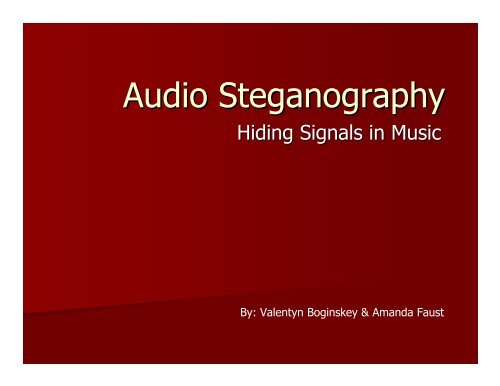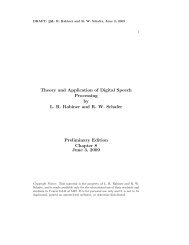Audio Steganography
Audio Steganography
Audio Steganography
You also want an ePaper? Increase the reach of your titles
YUMPU automatically turns print PDFs into web optimized ePapers that Google loves.
<strong>Audio</strong> <strong>Steganography</strong><br />
Hiding Signals in Music<br />
By: Valentyn Boginskey & Amanda Faust
Digital Watermarking<br />
Information is embedded directly into a digital<br />
signal.<br />
Terminology comes from the older technique of<br />
putting a visible watermark on paper, i.e., dollar<br />
bills, stamps, etc.<br />
Origins of watermarking found in the ancient art<br />
of steganography: in ancient Greek literally,<br />
“hidden hidden writing.” writing.<br />
Goal is dissimilar to cryptography, which renders<br />
the message unintelligible.
<strong>Audio</strong> Watermarking<br />
Goal is to transmit a message (sequence of bits) through a<br />
“noisy noisy” channel, where noise is original audio signal<br />
Requires design of an Emitter and Receiver to insert and<br />
decipher watermark, respectively<br />
Different Emitter/Receiver designs are required for different<br />
systems, i.e., Blind and Informed systems<br />
Some problems: Want low SNR but causes low bit rate, high<br />
error rate
Spread Spectrum Signals<br />
Signal energy is spread over wide band<br />
Unlikely to interfere with narrowband signals, and<br />
vice versa<br />
Difficult to intercept since spreading code is shared by<br />
Emitter and Receiver<br />
All of these things make spread spectrum signals<br />
secure, secret, and robust<br />
Drawback: Poor spectral efficiency
Two Common Spread Spectrum Systems<br />
Time Hopping (Direct Sequence) Sequence) <br />
– Signal occurs in one of several positions as<br />
determined by the spreading sequence<br />
– Obtained by multiplying each bit-sized bit sized period of<br />
the watermark signal by the spreading sequence<br />
– Fixed frequency technique<br />
Frequency Hopping<br />
– Frequency carrier quickly switches (“hops ( hops”) )<br />
between frequencies as determined by the<br />
spreading code<br />
– Fixed time technique
A Brief Explanation of the Direct<br />
Sequence Spread System (DSSS)
A Brief Explanation of the Receiver
Implementation of Blind DSSS<br />
Gain calculation based on arbitrary SNR<br />
Then use equation<br />
SNR = 20*log(gain^2 / var(audio_signal))<br />
to solve for gain<br />
gain = sqrt(10^(SNR/20) * var(audio_signal))<br />
Watermark is multiplied by spread sequence, multiplied<br />
by gain, added to original audio signal<br />
Original audio<br />
signal<br />
Watermarked<br />
audio signal
message =<br />
How can I be lost, / If I've got nowhere to go?<br />
/ Search for seas of gold / How come it's got so cold?<br />
/ How can I be lost? / In remembrance I relive<br />
/ And how can I blame you / When it's me I can't forgive?<br />
received_message =<br />
how can I bg$lost@ / Mf I've god nowhere to go:<br />
/ Search`f r qeaq of g ld / HoW come it's gOt so co~d?<br />
/ Hgw can I b% lost= / In rememrrance0I fe|kve<br />
/ And ho can I blamE yo}0/ When"it'spme I aan0 forgivg?<br />
number_of_erroneous_bits =<br />
41<br />
BER =<br />
0.0283<br />
MATLAB output
Implementation of Informed DSSS<br />
Gain calculation based off of information gathered from the original<br />
audio signal<br />
Original<br />
<strong>Audio</strong> Signal<br />
Watermarked<br />
<strong>Audio</strong> Signal
message =<br />
MATLAB output<br />
How can I be lost, / If I've got nowhere to go?<br />
/ Search for seas of gold / How come it's got so cold?<br />
/ How can I be lost? / In remembrance I relive<br />
/ And how can I blame you / When it's me I can't forgive?<br />
received_message =<br />
How can I be lost, / If I've got nowhere to go?<br />
/ Search for seas of gold / How come it's got so cold?<br />
/ How can I be lost? / In remembrance I relive<br />
/ And how can I blame you / When it's me I can't forgive?<br />
number_of_erroneous_bits =<br />
0<br />
BER =<br />
0
The watermark signal is very small compared to the original audio<br />
signal.
Informed DSSS using Shaping Filter<br />
Produces an inaudible watermark<br />
Creates an uncertainty factor in the<br />
decoding, leading to a somewhat high<br />
error rate<br />
Uses MPEG PAM filtering<br />
Original<br />
<strong>Audio</strong> Signal<br />
Watermarked<br />
<strong>Audio</strong> Signal
message =<br />
MATLAB output<br />
How can I be lost, / If I've got nowhere to go?<br />
/ Search for seas of gold / How come it's got so cold?<br />
/ How can I be lost? / In remembrance I relive<br />
/ And how can I blame you / When it's me I can't forgive?<br />
received_message =<br />
How can I(je lost, / If I'we god nowhere to!go><br />
/ Search$for seas$of gold / How come iu's f/u so!cold?<br />
*!Hnw "`n I be!most7 . Io remembranbe I relive<br />
/ Cnd how ccn0I blame you / Wxen it'r!md H!ban't forgiv%><br />
number_of_erroneous_bits =<br />
40<br />
BER =<br />
0.0276
The watermark signal is shaped more particularly to the specific<br />
audio signal.
Conclusions<br />
Blind DSSS<br />
–Audible watermark<br />
– High error rate<br />
Informed DSSS (no filtering)<br />
–Audible watermark<br />
–Error-free<br />
Informed DSSS (with shaping filter)<br />
– Inaudible watermark<br />
– High error rate
References<br />
– T. Dutoit, F. Marque (2008) ‘Applied Signal<br />
Processing,’ Ch. 7 pp 223‐264.

















